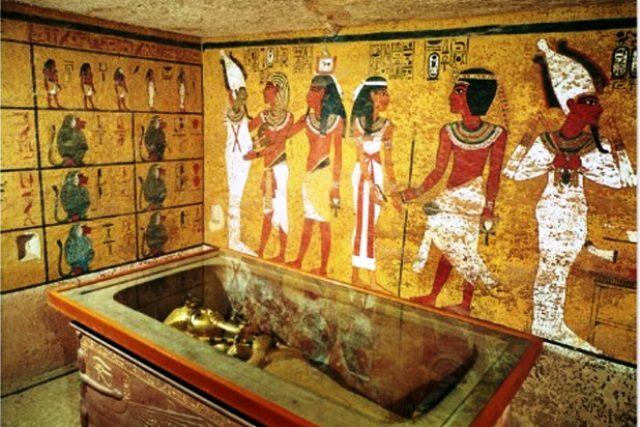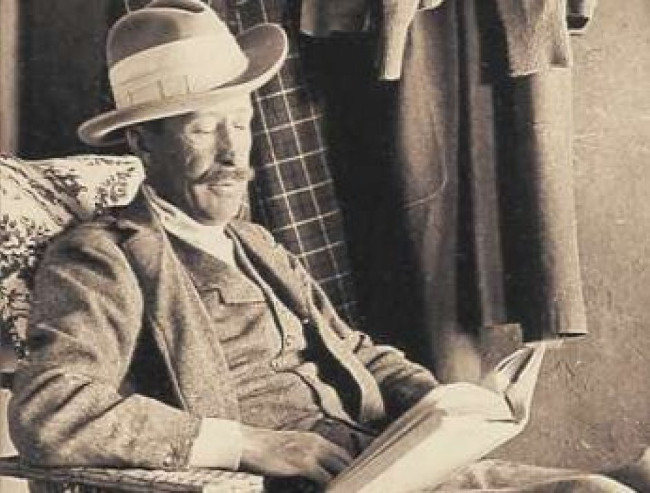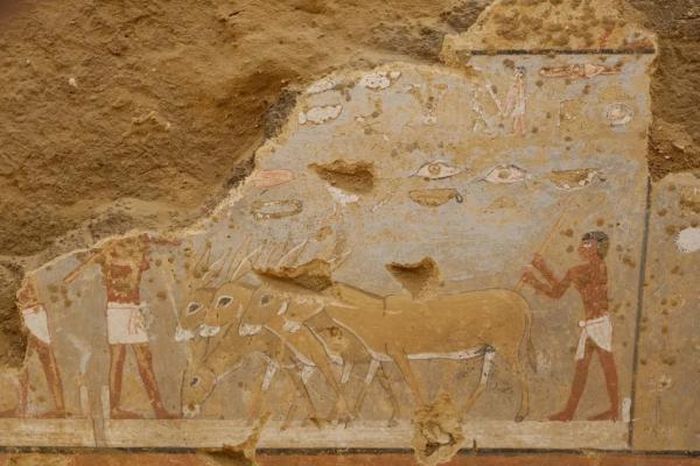Mysterious curse of Egyptian Pharaoh - Tutankhamun (part 2)
In 1922, the tomb and mummy of Pharaoh Tutankhamen, one of the most famous ancient Egyptian kings, was discovered opening a historic turning point in Egyptology. Besides this excavation also caused fears, bewildered by a series of deaths, bad luck happened to those who entered the tomb, harassing the rest of Pharaoh. Many believe that it is the fulfillment of the dreadful curse curse carved on the stone in front of the tomb.
- Mysterious curse of Egyptian Pharaoh - Tutankhamun (part 1)

Scientists have studied and hypothesized to explain the mysteries of mysterious deaths related to the tomb and mummy of King Pharaoh Tutankhamen .
When crippling some ancient Egyptian tombs in 2005, scientists discovered pathogenic bacteria such as staph, Pseudomonas, Aspergillus niger and Aspergillus flavus can cause allergies from pulses. blood, pulmonary hemorrhage. On the other hand, some tombs are also places where bats are hidden, and their droppings are capable of containing histoplasmosis, which causes illness like flu.
Ancient Egyptians prepared a lot of food from vegetables and fruits to meat for the dead to "use" on the way to the afterlife. They are the ideal environment for the development of insects, bacteria, mold, .

When analyzing the sample of air collected from inside a coffin that has not turned the lid through a drill hole, scientists have obtained scary results. The air contains high levels of ammonia gas, formaldehyde (used for embalming) and hydrogen sulfide (rotten, poisonous eggs). If they are at a high level, they can cause burns to the eyes and nose, pneumonia-like symptoms, and severe cases can even be fatal.
Since then, scientists have hypothesized to explain the count of Carnarvon's mysterious death after six weeks into the tomb due to contact with a poisonous mushroom or deadly bacterium.

But this hypothesis was rejected by some experts. They do not think that bacteria, mold inside the tomb are the cause of this earl's death. Because if they are, the symptoms will appear earlier than the 6-week period. DeWolfe Miller, a professor of epidemiology at the University of Hawaii, USA, has so far not recorded any cases of archaeologists or tourists sick from bacteria or mold in the tomb.
This hypothesis is not true for other deaths as well as the unfortunate things that happen to individuals believed to be related to the curse.

So what's the logical explanation for these scary mystery stories? A coincidence? Curse really inspired? All these questions still have no answers and are still a mystery.
You should read it
- Curse of the Dead Gods tips for beginners
- Review Game Curse of the Dead Gods: When choosing to survive is cursed
- 7 horrifying facts about ancient mummies
- How to add the Instagram curse filter
- Close-up of the 3,300-year-old golden coffin of pharaoh Tutankhamun
- The groundbreaking archaeological findings about ancient Egypt
- What is lol? LOL how to understand it right
- Timeless and mysterious disappearances break all physical laws in the mountains of Untersberg
May be interested
- In addition to pyramids, Egypt has a vast labyrinth that is not yet known!
 the egyptian national institute of geophysical and astronomical studies is analyzing labyrinth scanning data to produce detailed 3d comparison images.
the egyptian national institute of geophysical and astronomical studies is analyzing labyrinth scanning data to produce detailed 3d comparison images. - Timeless and mysterious disappearances break all physical laws in the mountains of Untersberg
 the phenomenal anomalies and unbelievable mysterious disappearances have occurred for hundreds of years in the mountains of untersberg - the haunted mountain range in europe has led scientists to suffer.
the phenomenal anomalies and unbelievable mysterious disappearances have occurred for hundreds of years in the mountains of untersberg - the haunted mountain range in europe has led scientists to suffer. - Curse of the Dead Gods tips for beginners
 curse of the dead gods is an excellent roguelike game, full of difficulty and challenge in a gritty and complex world. beautiful but equally terrifying temples filled with monsters and traps await players.
curse of the dead gods is an excellent roguelike game, full of difficulty and challenge in a gritty and complex world. beautiful but equally terrifying temples filled with monsters and traps await players. - 4,300 year old color painting in an ancient Egyptian tomb
 an ancient egyptian tomb, named mastaba - mast, discovered in the dahshur pyramid cemetery 25 kilometers south of the egyptian capital cairo, surprised scientists when witness what was found inside.
an ancient egyptian tomb, named mastaba - mast, discovered in the dahshur pyramid cemetery 25 kilometers south of the egyptian capital cairo, surprised scientists when witness what was found inside. - Endless Nightmare 5: Curse PC
 endless nightmare 5: curse will be the next part in the endless nightmare game series in which players will experience another unique scary style.
endless nightmare 5: curse will be the next part in the endless nightmare game series in which players will experience another unique scary style. - Review Game Curse of the Dead Gods: When choosing to survive is cursed
 inspired by the exploration of the cursed aztec temple, curse of the dead gods attracts gamers by its gameplay when it brings you the same difficulty as dark soul.
inspired by the exploration of the cursed aztec temple, curse of the dead gods attracts gamers by its gameplay when it brings you the same difficulty as dark soul. - The two mysterious rooms in the Great Pyramid of Giza cause scientists a headache
 using x-ray technology with muon radioactive particles, researchers of the pyramid discovered two mysterious rooms inside the 4,500-year-old giza pyramid in egypt.
using x-ray technology with muon radioactive particles, researchers of the pyramid discovered two mysterious rooms inside the 4,500-year-old giza pyramid in egypt. - The secret of the larger pyramid works in Egypt
 pyramids are ancient buildings built in many different civilizations. although it has been discovered and studied for a long time, we still have not seen all the pyramids built by ancient people in the world. here are three places with pyramids larger than the famous egyptian pyramid that few people know.
pyramids are ancient buildings built in many different civilizations. although it has been discovered and studied for a long time, we still have not seen all the pyramids built by ancient people in the world. here are three places with pyramids larger than the famous egyptian pyramid that few people know. - The 'eccentricities' are only found in ancient Egypt
 until now, researchers have discovered a number of mysteries about humans, ancient egyptian customs such as golden skincare, cat worship, using giraffes as gifts to show strength. ..
until now, researchers have discovered a number of mysteries about humans, ancient egyptian customs such as golden skincare, cat worship, using giraffes as gifts to show strength. .. - Excavation of a thousand-year-old Egyptian tomb reveals the mummy in an 'intact' state.
 an ancient egyptian tomb that kept a very good mummy has just been found causing a stir in the middle east.
an ancient egyptian tomb that kept a very good mummy has just been found causing a stir in the middle east.










 Top 10 interesting facts about the number 13 in the dark
Top 10 interesting facts about the number 13 in the dark Looking for the reason why the ancient Egyptians stopped building pyramids?
Looking for the reason why the ancient Egyptians stopped building pyramids? The 5 most mysterious legends in the magnificent city of Paris
The 5 most mysterious legends in the magnificent city of Paris Single way against evil spirits of the old
Single way against evil spirits of the old The mystery of dead women still gives birth
The mystery of dead women still gives birth 4 most mysterious mystery submarine incidents in military history
4 most mysterious mystery submarine incidents in military history